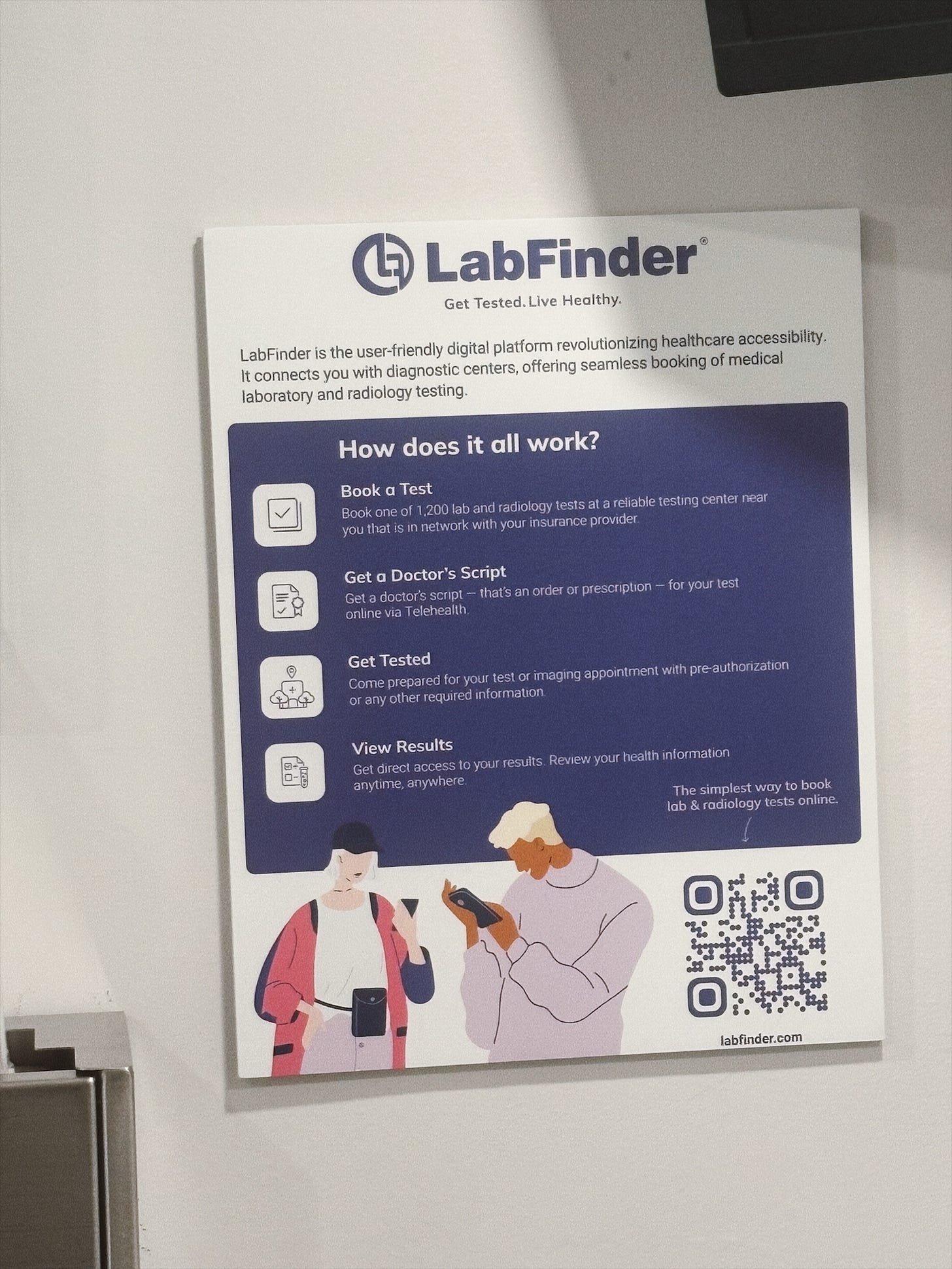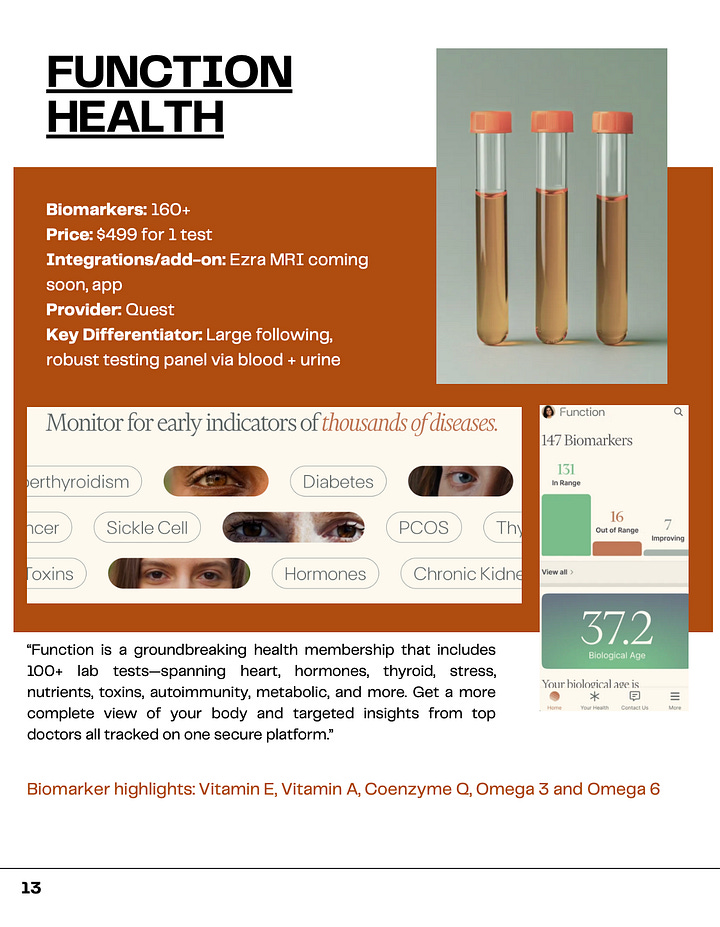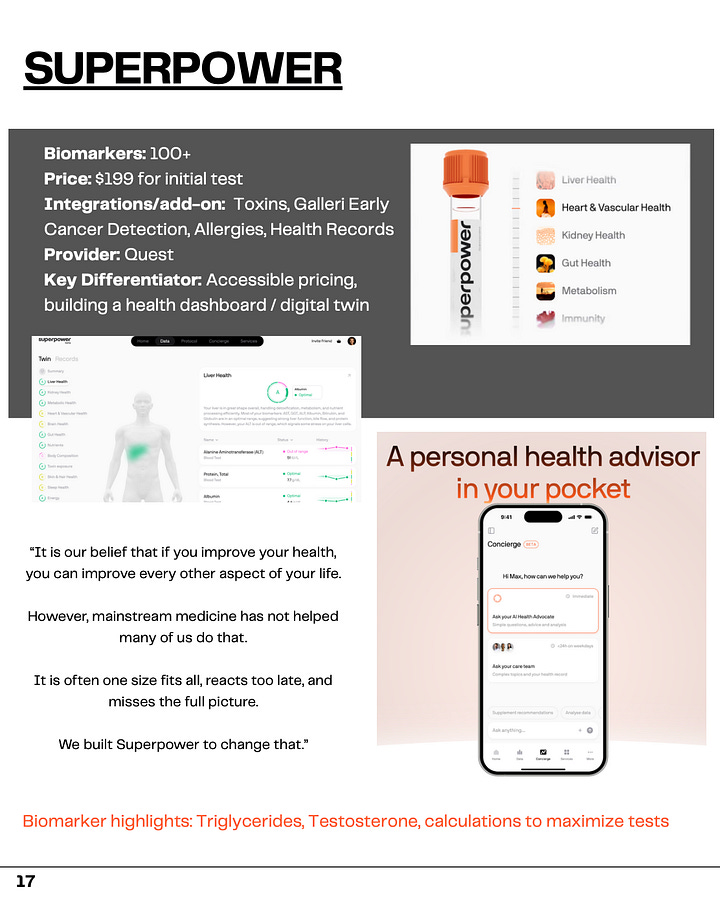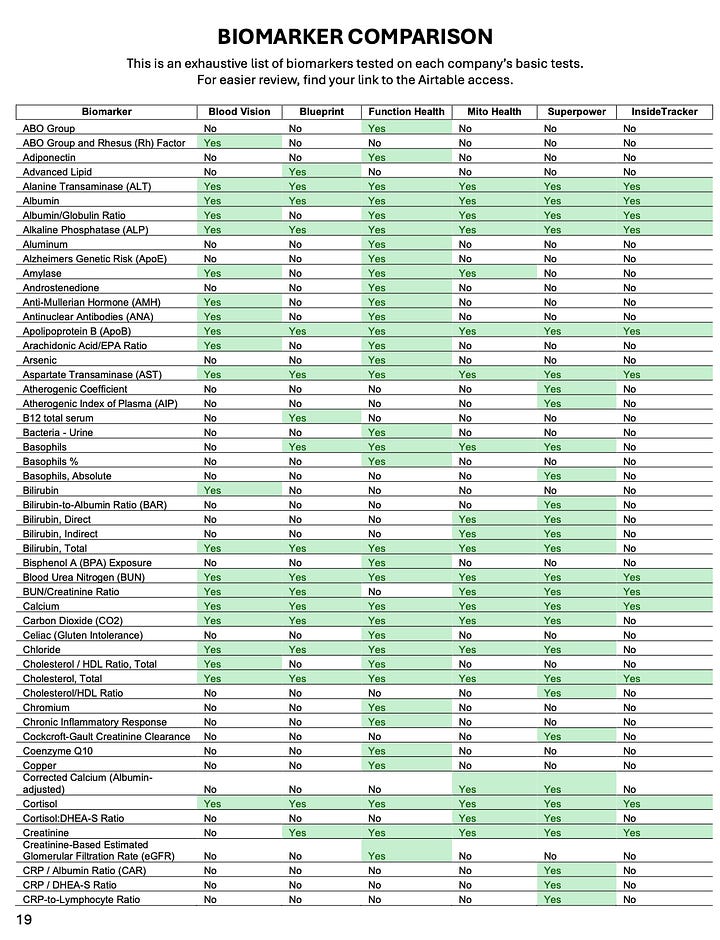Decoding diagnostics: blood testing in consumer health
#53 your guide to navigating blood work beyond the doctor's office
Dear humans, Today’s post is a deep dive into the many blood testing services available and how they’re shaping a new norm for consumer healthcare. I’ve pulled together a guide to help you compare what’s out there, motivated by my own search for comprehensive, cost-effective testing. I’ll be sharing which one I decided to try out in following posts!
for easier navigation:
Bringing blood testing closer to you
Demand for testing drives costs down
The digital world is primed for consumer health
Similar, but different testing companies
The next push for comprehensive testing
Invitation to Dx Decode: Blood Work Buyer’s Guide
A few months ago, after seeing a cardiologist for irregular heart rate (picked up on my Ōura) and getting an unclear ultrasound, I had my most comprehensive blood panel run.
It was over 20 markers including thyroid hormones and a complete blood count.
The results suggested “early” Hashimoto’s and my doctor simply recommended minerals and salt tablets while waiting to “see if it worsens.”
That moment made me realize how little testing I’d had before. This was only my second blood test in 30 years!
Growing up in rural Upstate New York, going to the doctor was for maintenance or when something was wrong. Comprehensive testing for prevention and optimization just weren’t part of the approach.
I think this a common American experience with healthcare:
In both wellness and medicine, supplements and prescription drugs are recommended without a solid baseline of the body’s chemistry.
Too often, conditions are only taken seriously once symptoms progress enough to warrant a documented plan of action.
Lastly, access to specialized doctors and experts for uncommon diseases often depends on a patient’s own advocacy and, simply put, shopping around.
But it’s changing.
After my doctor denied additional tests that were relevant to Hashimoto’s, I noticed a LabFinder poster across the room.
I was able to scan the QR code from the exam table and book the thyroid panel I wanted. This was on my own with a different doctor via their telehealth platform, before I left the office.

Patients, whether they are scientists like me or not, want more data, more insights, and more care beyond being told to take salt tablets.
Companies are listening and health systems will inevitably catch-up. The new normal may look more like blood work on a yearly or bi-yearly basis, similar to the cadence of a dental cleaning or annual women’s exam.
Bringing blood testing closer to you
The biggest players, Quest Diagnostics and Labcorp, are now offering patient-directed lab tests across their thousands of sites worldwide. Even Amazon is entering the space, first launching blood testing in India, alluding to a build towards more on-demand care.
At the same time, smaller startups fill the gaps with better design, at-home kits, and concierge-like services managed over their user-centric platforms.
Think of it like this: big companies are like oil tankers. They only shift course when the demand is undeniable, to reduce risk. Startups are more like speedboats. They’re nimble enough to navigate around tides and the larger ships. Startups pivot fast and think independently. Taken together, the actions of large and small companies signal the consumer-centric focus is here to stay.

What happens in the UK is also often a signal of what’s to come in the U.S. because of less regulatory restrictions. Companies like Forth and Daye have already launched at-home finger-prick kits for blood testing. Some players in the U.S. have followed suit, Siphox Health has an interesting “painless” collection product equipped with several panels.
This movement puts ownership of ordering tests and viewing data directly into patients’ hands.
And for women’s health, the impact could be significant. Half of women report skipping their annual exam, understandably so. Excitingly though, the most critical element —pap smears—is shifting towards less-invasive methods. Options like Qvin’s Q-pad, which tests menstrual blood, and Teal’s Wand, which screens for high-risk HPV, are paving the way. Thank goodness!
Demand for testing drives costs down
While the options for blood work require out-of-pocket, HSA/FSA, or higher-deductible spends, growing demand and competition reduces prices.
Just this week, Superpower (a newly launched blood testing company) dropped it’s offering to $199 and Mito Health followed suit with a $350 offer. The $199 plan is about $16 a month, cleverly framed and compared to a Netflix subscription.
The reduction matters. Five hundred dollars for a test, which was the previous price rate, could equal more than a month’s worth of groceries for some individuals and families.
More accessible entry points drive the adoption, which then drive the pricing offered by both the startup companies and the large providers.
The question then becomes, at what point do Quest and Labcorp or others like Amazon or Apple Health acquire the small messenger companies. The answer may lie in the broader need for conglomerate platforms and integrated systems that enable patient communication to AI and specialized doctor’s.
The digital world is primed for consumer health
Digital infrastructure is catching up to the demand for more patient-centered management of care. Platforms have emerged that allow health records to live in one place. This gives patients, not just providers, ownership of their data.
Tools like PocketHealth make radiography images easy to store and view, while AI tech giants like Tempus AI continue to acquire algorithms and diverse file formats.
Other companies are making it easier to find and order tests. Rupa Health simplifies how physicians order comprehensive test panels while providers like Superpower and MitoHealth allow patients to order their own.
There’s a lot of chatter that the biggest company in the world will be a consumer health giant.
“It will be a consumer-obsessed, healthcare-native tech company that reimagines what care can look like.” - Daisy Wolf and Vijay Pande on AndreessenHorowitz.com
It’s interesting, at least to me, to imagine what companies will lead in 5 years and how they will impact medicine.
Another layer is the goldrush of AI and how it’s integration to a variety of datasets is surely to change discovery forever. It will fundamentally shift how the world works. Imagine the power of analyzing the massive amounts of data from the population with less bias, less ego, and more abundance.
And we’ve already talked about wearables. These hardware companies are also claiming their stake in the market. Being as open-source as possible, Ōura, for example, is integrated with various companies like Dexcom. Superhuman and WHOOP have announced their own concierge blood testing services, offering testing directly to their users. Integrating heart rate and sleep data with blood results will provide unique insights.
Why does more testing matter?
Blood testing matters because it provides a real-time snapshot of how the body is functioning. There are thousands of markers that can be tested through our blood. Reviewing them can reveal nutrient deficiencies (Iron, Magnesium, Zinc, etc.), suggest inflammation (HS-CRP), and show early signs of disease (ie. TPO antibodies).
The more markers we test and the better the interpretation is of them, the more complete the landscape of our biology becomes. This helps move from guesswork (“you’re tired in the morning, your cortisol and stress might be high”) to informed decisions (“your Iron levels are low, supplementing at X dose or transfusions may be the best course of action”).
To reduce the complexity of the many test and markers, a categorization by their system is a common reference as follows:
HEART: Apolipoprotein B (ApoB), Cholesterol / HDL Ratio, HDL Cholesterol, HDL Large, LDL Cholesterol, LDL Medium, LDL Particle Number, LDL Pattern, LDL Peak Size, LDL Small, Lipoprotein (a), Lipoprotein Fractionation, Non-HDL Cholesterol, Total Cholesterol, Triglycerides
THYROID: Iodine, Selenium, Thyroglobulin Antibodies (TgAb), Thyroid Peroxidase Antibodies (TPO), Thyroid-Stimulating Hormone (TSH), Thyroxine (T4) Free, Triiodothyronine (T3) Free
AUTOIMMUNITY: Antinuclear Antibodies (ANA) Pattern, Antinuclear Antibodies (ANA) Screen, Antinuclear Antibodies (ANA) Titer, Celiac Disease (Comprehensive Panel), Rheumatoid Factor
IMMUNE REGULATION: High-Sensitivity C-Reactive Protein (hsCRP), White Blood Cell Count (WBC), Neutrophils, Lymphocytes, Monocytes, Eosinophils, Basophils
FEMALE HEALTH: Anti-Mullerian Hormone, Estradiol (E2), Follicle Stimulating Hormone (FSH), Luteinizing Hormone (LH), Prolactin
MALE HEALTH: DHEA-Sulfate, Estradiol (E2), Follicle Stimulating Hormone (FSH), Luteinizing Hormone (LH), Prostate Specific Antigen (PSA), Testosterone
STRESS & AGING: Cortisol, DHEA Sulfate, Biological Age
METABOLIC: Adiponectin, Glucose, Hemoglobin A1c (HbA1c), Insulin, Leptin, Uric Acid
NUTRIENTS: Arachidonic Acid/EPA Ratio, Copper, Ferritin, Homocysteine, Iron, Iron % Saturation, Iron Binding Capacity (TIBC), Magnesium, Methylmalonic Acid (MMA), Omega 3 Total, Omega 3: EPA+DPA+DHA, Omega 6 Total, Omega 6: Arachidonic Acid, Omega 6: Linoleic Acid, Omega 6/Omega 3 Ratio, Selenium, Vitamin D, Zinc
LIVER: Alanine Transaminase (ALT), Albumin, Alkaline Phosphatase (ALP), Aspartate Transaminase (AST), Gamma-glutamyl Transferase (GGT), Total Bilirubin, Total Protein
KIDNEYS: Albumin (Microalbumin) - Urine, Blood Urea Nitrogen (BUN), BUN / Creatinine Ratio, Calcium, Carbon Dioxide, Chloride, Creatinine, Estimated Glomerular Filtration Rate (eGFR), Globulin, Potassium, Sodium
And the list goes on, this one above was from Function Health’s website.
Thanks to the internet, there are various resources that summarize each marker and link them to systems and conditions. There’s also different guides for what are “optimal ranges” beyond standardized “reference ranges” set by CLIA and CAP guidelines. The motivation here is that reference ranges are population based and with at least 50% of the population experiencing a chronic disease, our baseline is far from “optimal.”
A couple of resources I’ve come across include OptimalDX by Dr. Dicken Weatherby, Forth’s Biomarker A-Z guide, and InsideTracker’s Biomarker Guide. Each of the blood testing companies seem to follow reference ranges and their own optimal range for each marker based on partner clinicians and AI.
In the guide, you will find a cross comparison of all of the markers offered by Superhuman, Blueprint, Function Health, Mito Health, InsideTracker, and Blood Vision. Snapshot below. If useful, I’ll keep building on this.
Similar, but different testing companies
I’ve pulled together the most popular options I’ve found so far and summarized them from the consumer perspective. While their testing services are similar, comprehensive over a wide range of body systems, their packages offer different result summaries, integrations, and add-on testing capabilities.
A newly released testing platform from wearable company Ultrahuman, with a low-cost ($198) offering and a unique integrated data platform, UltraTrace.
The most comprehensive health testing platform, Blueprint unites strict routines, cutting-edge tech, and unparalleled DNA methylation analysis (as an add-on). Pricing at $375+.
Likely the most widely followed testing platform, Function Health has expanded to 160+ biomarkers with toxin and early cancer screen add-ons, and is preparing to launch Ezra MRIs. Starting at $499.
A legacy platform launched in 2015, InsideTracker enables uploads of DNA, blood, and wearable data for analysis, and offers blood testing for 48 markers with genomic sequencing. Their data only package is $149 and blood tests begin at $489.
Positioned between the doctor’s office and direct-to-consumer platforms, LabFinder serves as a lab testing portal, coordinating with telehealth providers to order smaller panels or diagnostic tests, typically processed through insurance for a fee. Small panels at $60+ and a physician fee.
Another comprehensive and user-friendly platform, MitoHealth offers standard or customizable packages with the ability to test with Prenuvo MRI, DEXA scans, VO₂ max, and other prior health records. Starting at $350.
Youth-driven and tech-savvy, Superpower delivers a sleek platform with data integration, marketplace features, chat and AI, and upcoming integrated tests—priced accessibly at $199.
For a lot more information, the Blood Work Buyer’s Guide includes a PDF and database (via AirTable) that compares the offerings and my personal picks. This information is difficult to find and compare in one place. I hope this makes it easier for you to decide AND potentially save some funds.
The next push for comprehensive testing
We need to be clear: blood testing is a snapshot of what’s happening inside the body. As one of my biochemistry professors used to say, “Timing when to measure reactions in a cell is like trying to guess when the bus will arrive in a city you’ve never been to.”
Our cells and our lives are complex and dynamic. Reactions happen in milliseconds and run rhythmically.
The next wave of innovations will test more markers and more frequently, but also more often, even continuously. They will integrate data at different scales, from whole-body imaging to genetic modifications and mitochondrial function.
Only then will we progress from snapshots to something closer to a film. With the help of computation, we’ll reveal more patterns, track changes, and capture the bigger picture.

Invite to Diagnostics Decode: Blood Work Buyer’s Guide
I’ve created a 25-page buyer’s guide AND Airtable database to help you shop and make an informed decision.




All paid subscribers to Club Karpé Diem will be receiving access.
Free subscribers are invited to upgrade to a paid tier or purchase access for $11 via this link: Dx Decode: Blood Work Buyer’s Guide
Stay tuned for my next posts that will cover:
1) the newest companies releasing technologies that will answer some of these tougher questions!
2) my personal experience with choosing one of these blood testing options
What do you think about blood testing and consumer health? What are looking out for? Let’s chat in the comments !!
talk soon,
Kelsey





